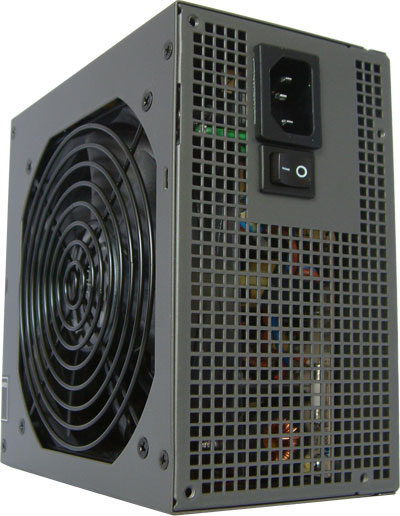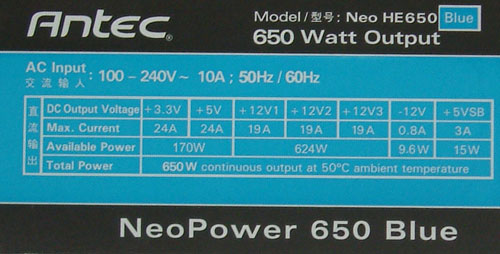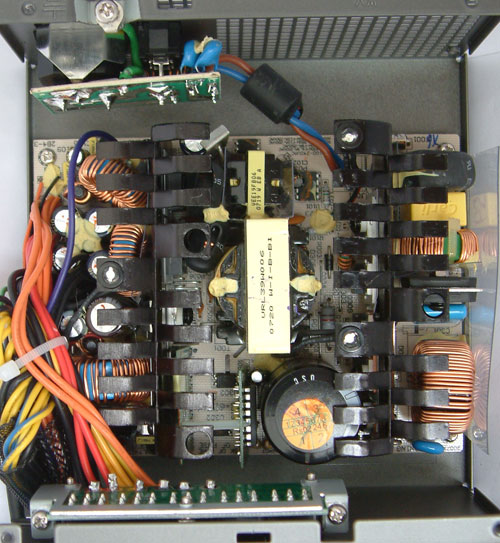Power Supply Roundup: 650W-680W
by Christoph Katzer on February 21, 2008 2:00 AM EST- Posted in
- Cases/Cooling/PSUs
Antec NeoPower 650 Blue

The NeoPower 650 Blue is a new entrant in the market that hasn't received much attention until now. It comes in a dark anthracite color called Gunmetal Black. The NeoPower 650 Blue appearance is typical of Antec PSU, with little to set it apart from other models. It has a 120mm fan on the bottom of the power supply that blows at the heatsinks inside. The back features square-shaped holes over the majority of the surface. The PSU comes in Antec's standard package with a paper shell to protect the power supply.

Like other power supplies from Antec, the NeoPower comes with three 12V rails rated at 19A. The total combined power of the rails is 624W, which is normal for a 650W power supply, and the 3.3V and 5V combined power is 170W. In fact, all the other power supplies today have the exact same combined power rating.

The NeoPower 650 Blue comes with a partial cable management system, allowing the user to disconnect several cables. The jacks on the PSU are a 6-pin design, which has proven effective with other models and manufacturers. With cable management, it is crucial to have a good connection between the cables and the power supply in order to avoid increasing the resistance.

Opening this unit shows a design we've seen quite a few times now. You can see several small holes in the heatsinks, three of which hold the blue LEDs. These LEDs light up when the system is in operation, illuminating the PSU and case interior. The two heatsinks look quite tiny, but with good designs and a moderate 650W rating there is no need for bulky heatsinks. Later we will see that this unit has a high level of efficiency, which leaves less heat to dissipate. While the Seasonic design and layout have been around a while, they still do quite well. As competition heats up, we expect to see some new designs, but there is no need yet. As the saying goes, if it's not broken, don't fix it.










23 Comments
View All Comments
larson0699 - Monday, August 4, 2008 - link
You mentioned that the label on the Thermaltake unit doesn't state maximum combined load of the lower-volt rails.But look, it does. 180 Watts.
BRDiger - Tuesday, July 29, 2008 - link
I kind a wondering because comparing the efficiency level of the Be Quiet! to the testing datasheet on the 80plus.org site it just reaches about 80% at 100% load unlike your results with nearly 84%. Comparing it to the Enermax Modu 82+ review here, it even exeeds its efficiencyJust wondering and it´s not supposed to be an offence...
BRDiger - Tuesday, July 29, 2008 - link
Well, after reading another review it seems that 80plus was actually wrong and the be quiet!s performance exeeds the enermax..strikeback03 - Friday, February 22, 2008 - link
Thermal and fluids was not my best subject in school, but don't fans usually lose air off the tips of the blades, not suck it in? That is my experience with the Zerotherm Nirvana, which seems to make the same claim of sucking air in with its open fan.mo3 - Friday, February 22, 2008 - link
The new Enermax Modular 82+ & Pro 82+ can peak over 700Watts with out a problem; also they have the ATX12v V2.3 and reaching 88% efficiency.Modular 82+ has 2x 12 pin connection embedded for up and coming graphics cards and greater stability.
Just to give the readers a better alternative! :)
Check out more info at: www.enermax.co.uk
crimson117 - Friday, February 22, 2008 - link
Okay... PSU review.. new 9600 GT review... I think anandtech is trying to tell me I need a new computer!NINaudio - Thursday, February 21, 2008 - link
Hi, you mention that the be quiet! PSU is quiet but also runs warmer than the others. Where are the temperature charts that we've seen in previous PSU reviews? It would be good to see the temperatures that you sacrifice for a quieter PSU. Is it a degree, 5 degrees, ten degrees, more?tynopik - Thursday, February 21, 2008 - link
1. include a real stress test like how the units handle rapidly changing input voltagesay load them up to 80% capacity and then connect them to a variac and dip the voltage to ~90V 3 times in quick succession to simulate a brownout or poor electrical conditions and check that
a) it doesn't blow up
b) it maintains quality output while the input if fluctuating
2. include cheapo units for comparision just for the reminder of what a poor quality unit is
3. i really love your connector length charts, far more useful than the usual 'stetch a jumble of cables out and lay a ruler next to it' approach. i just wish you would do the same for the sata/peripheral connectors
4. i'm really like the way you combined all the acoustic and efficiency charts together instead of having a bunch of individual charts
Christoph Katzer - Thursday, February 21, 2008 - link
I just assembled a nice system do to those tests. Once it's up and running I will include it. Will also make a comparison of all cables from now on, thanks.The problem with cheap units is that they are mostly for a specific market. I would need to buy thise units myself since no company would ever send them over. Since I am not in the US I will only have the stuff from Europe which is not even available in the US. But let us see how we could change that in the future...
jtleon - Thursday, February 21, 2008 - link
Chris,You state that at least 100W must be drawn before these units achieve high efficiency. Can you relate this requirement to most normal PC tasks - i.e. browsing the web (reading Anandtech reports of course), answering email, other office based activities (the majority of PC users on the planet), rather than those hardcore gamers that are gaming around the clock (and clearly are independently wealthy!).
It would appear that these PSU's are not going to efficiently reduce the carbon footprint of the majority of PC users on this planet.
Am I wrong?
Regards,
jtleon